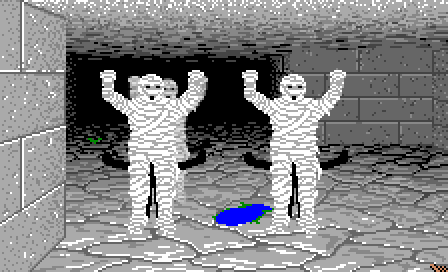Downloads
Executable for the map editor - exactly the same as in part 40 (Windows 32bits)
Executable for the game (Windows 32bits)
Before you try to compile the code go to the "Projects" tab on the left menu, select the "Run" settings for your kit,
and set the "Working directory" to the path of "editor\data" for the editor or "game\data" for the game.
Group behaviors
behaviors. It can either:
- Wander around randomly if it didn't see you.
- Seek your party to get close to it.
- Fight you when it is on a neighboring tile.
- Flee away from you when the monsters took too much damages.
that right now.
To implement this type of A.I. in a game we generally use a "finite state machine".
But don't be afraid, it's not as complex as is sounds.
In a finite state machine, a system can have several states. Here our monsters' group can be in 4 states - Wander,
Seek, Fight or Flee.
And under specific conditions, we can transition from one state to another.
In this part we will use only 2 states: Wandering and Fight.
- In the wandering state we will do nothing. The monster won't even move, we will see that in another part.
- In the fight state, the monsters inside the group will launch an attack animation at random times.
Now for the transitions:
- When we are wandering, if the player is on one of the 4 neighbor tiles, we go to the fight state.
- When we are in the fight state, if the player is farther than the neighbor tiles, we go back to wandering.
Here is an image that should be clearer:

Implementing the states
Now, as they will become more complex and have their own methods, it is simpler to define them as separate classes.
//---------------------------------------------------------------------------------------------
class CMonster
{
public:
[...]
EMonsterPos pos;
EMonsterDir dir;
int life;
[...]
};
//---------------------------------------------------------------------------------------------
class CMonsterGroup2
{
public:
[...]
CMonster monsters[4];
EMonsterDir dir;
[...]
};
"map.h".
Now, as we said, each monster group is in a given state - either wander or fight.
So we will add a "state" variable to them:
enum EMonsterState
{
eMonsterState_Wandering,
eMonsterState_Fight
};
class CMonsterGroup2
{
public:
[...]
EMonsterState state;
};
This function will call either a wander() or a fight() function depending on the current state of the group.
void CMonsterGroup2::update(CVec2 mapPos, uint8_t type)
{
[...]
// handle group behavior for each state
switch (state)
{
case eMonsterState_Wandering:
wander(mapPos, type);
break;
case eMonsterState_Fight:
fight(mapPos, type);
break;
}
}
position of the player.
//---------------------------------------------------------------------------------------------
void CMonsterGroup2::wander(CVec2 mapPos, uint8_t type)
{
// transition to fight state ?
CVec2 dist = player.pos - mapPos;
bool isNearPlayer = (dist.x == 0 && ABS(dist.y) == 1) || (dist.y == 0 && ABS(dist.x) == 1);
if (isNearPlayer == true)
{
state = eMonsterState_Fight;
[...]
}
}
//---------------------------------------------------------------------------------------------
void CMonsterGroup2::fight(CVec2 mapPos, uint8_t type)
{
// transition to wandering state ?
CVec2 dist = player.pos - mapPos;
bool isNearPlayer = (dist.x == 0 && ABS(dist.y) == 1) || (dist.y == 0 && ABS(dist.x) == 1);
if (isNearPlayer == false)
{
state = eMonsterState_Wandering;
}
}
void CMonsterGroup2::update(CVec2 mapPos, uint8_t type)
{
// update all the monsters of the group
for (int i = 0; i < 4; ++i)
if (monsters[i].pos != eMonsterPosNone)
monsters[i].update(*this, mapPos, type);
[...]
}
Monsters behaviors
So the update function of each monster will call either a wander() or a fight() function too.
void CMonster::update(CMonsterGroup2& group, CVec2 mapPos, uint8_t type)
{
displayAttackTimer.update();
switch (group.state)
{
case eMonsterState_Wandering:
wander();
break;
case eMonsterState_Fight:
fight(mapPos, type);
break;
}
}
But in the fight state we want to launch the monster's attack animation randomly.
Now let's have a look at the values we will need.
Attack parameters
<monsters>
[...]
<!-- 01 Giant Scorpion -->
<monster name = "MONSTER01">
[...]
<time_between_atk>200</time_between_atk>
<atk_display_time>40</atk_display_time>
<atk_sound>Attack_Scorpion.wav</atk_sound>
[...]
</monster>
- time_between_atk is the minimum time between 2 attacks. We will add a random value to it.
- atk_display_time is the duration of the attack animation. In this game the animations consist in a single
image that will be displayed during this time. - atk_sound is the name of the sound that will be played. Note that some monsters don't have any sound.
To handle these times we will add timers to our monster:
class CMonster
{
public:
[...]
CTimer displayAttackTimer;
CTimer nextAttackTimer;
};
void CMonster::initNextAttack(uint8_t type)
{
int minTime = monsters.monstersDatas[type].timeBetweenAttack;
int nextTime = minTime + (rand() % 40) - 10;
if (minTime > 150)
nextTime += (rand() % 80) - 20;
nextAttackTimer.set(nextTime, true);
}
And at the same time, we will turn the monster towards the player:
void CMonsterGroup2::wander(CVec2 mapPos, uint8_t type)
{
// transition to fight state ?
[...]
if (isNearPlayer == true)
{
state = eMonsterState_Fight;
// direction towards the player
EMonsterDir dir;
if (dist.x > 0)
dir = eMonsterDirRight;
else if (dist.x < 0)
dir = eMonsterDirLeft;
else if (dist.y > 0)
dir = eMonsterDirDown;
else
dir = eMonsterDirUp;
// initialize each monster of the group
for (int i = 0; i < 4; ++i)
if (monsters[i].pos != eMonsterPosNone)
{
monsters[i].dir = dir;
monsters[i].initNextAttack(type);
}
}
}
When it finishes, we play the attack sound, start the display timer and relaunch the "between attacks" timer.
void CMonster::fight(CVec2 mapPos, uint8_t type)
{
if (nextAttackTimer.update() == true)
{
QString soundName = monsters.monstersDatas[type].attackSound;
if (soundName.isEmpty() == false)
sound->play(mapPos, soundName.toLocal8Bit().constData());
int attackTime = monsters.monstersDatas[type].attackDisplayTime;
displayAttackTimer.set(attackTime, true);
initNextAttack(type);
}
}
Displaying the attack

We saw the attack sprites in the previous part.
Note that they only replace a "facing" image - we don't have attack sprites for the sides or for the back.
So, when we get the sprite for the monster in CMonsters::draw() we only have to test if the display timer is running
in the case of a facing monster:
// sprite
[...]
if (tableDir == eMonsterDirDown)
{
// facing
if (monster.displayAttackTimer.isRunning())
{
// attack
spriteName = monstersDatas[type].attackImage;
if (spriteName.isEmpty() == true)
spriteName = monstersDatas[type].frontImage;
}
else
{
// normal
spriteName = monstersDatas[type].frontImage;
}
}
[...]